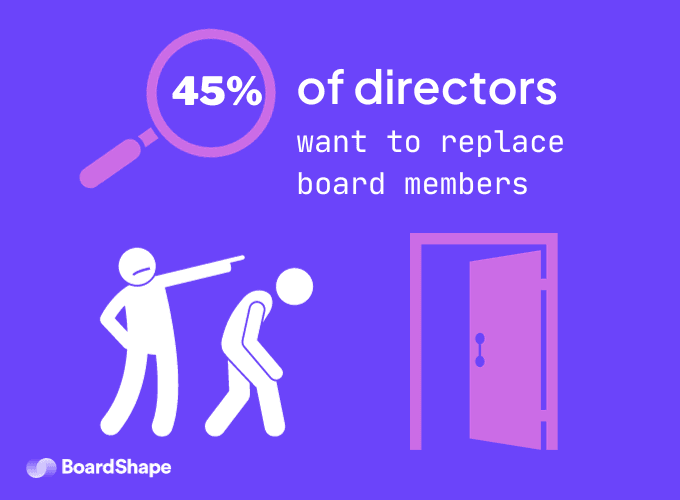If you feel like a board you are sitting on is showing signs of disfunction or toxicity you are not alone. PwC’s 2023 Annual Corporate Directors Survey found that 45% of directors want someone on their board replaced.
 A toxic board severely damages a company's culture, success, and reputation. While identifying the signs and characteristics of a problematic board is crucial, it's also important to delve deeper into the consequences, which often mirror the signs of a dysfunctional company. Poor leadership can breed mistrust, drop morale, and hinder productivity. This leads to missed opportunities, stalled innovation, and both legal and financial risks. Here are 12 indicators that suggest an ineffective board:
A toxic board severely damages a company's culture, success, and reputation. While identifying the signs and characteristics of a problematic board is crucial, it's also important to delve deeper into the consequences, which often mirror the signs of a dysfunctional company. Poor leadership can breed mistrust, drop morale, and hinder productivity. This leads to missed opportunities, stalled innovation, and both legal and financial risks. Here are 12 indicators that suggest an ineffective board:
1. Lack of confidentiality
Boards handle sensitive information, making confidentiality paramount. A board's inability to maintain confidentiality is a glaring sign of dysfunction. If board members frequently discuss sensitive matters outside of official channels or if confidential information finds its way into public or unauthorized domains, it raises red flags. Such breaches not only risk legal and financial repercussions but also erode trust within the board and the broader organization.
2. Conflicting Agendas
 Boards need open discussions, but conflicting agendas among directors are a serious problem for board dynamics. To effectively guide the organization and make sound decisions, all members must align on future direction and initiatives. While debate is welcome on specific points, there should be general alignment with the head of the organization. Promptly addressing toxic conflicting agendas is crucial for a healthy board environment.
Boards need open discussions, but conflicting agendas among directors are a serious problem for board dynamics. To effectively guide the organization and make sound decisions, all members must align on future direction and initiatives. While debate is welcome on specific points, there should be general alignment with the head of the organization. Promptly addressing toxic conflicting agendas is crucial for a healthy board environment.
3. Disorderly Behavior
Disorderly behavior in a board isn't just about members talking over each other. When the board doesn't follow a structured approach, it can be a red flag signalling deeper issues. This lack of discipline can mean vital topics are overlooked, decisions become hasty, and long-winded disputes replace productive dialogue. Such erratic behavior can ripple down, influencing the wider organization. Employees might question the board's capability, stakeholders may lose confidence, and the company's strategic direction might blur. Ultimately, consistent disorder not only breeds a toxic board culture but can also jeopardize the company's overall stability and reputation.
4. Lack of Respect in the boardroom
Boards must place respect at the forefront of their culture. A lapse in this can create a toxic environment. History has shown instances of flawed boardroom behaviors, with many companies facing criticism at the boardroom level. In today's diverse workforce, it's vital for everyone in the workplace to show sensitivity and respect. A new CEO's duty is to set a respectful tone. If neglected, the repercussions can be severe. For a deeper understanding, consider reviewing this case study on ethics in the boardroom. It's essential for the entire board to focus on the company's goals and approach disagreements with care and tact.
5. Hostile Environment

When board members don't get along this can lead to boardroom issues, creating an unproductive and potentially hostile environment. Therefore it is crucial to encourage positive communication from the beginning. However, even with everyone's good intentions, it is unrealistic for everyone to be best friends at all times.
Therefore, it is important to stay vigilant and ensure that board meetings never devolve into personal attacks. Once things become personal, productivity will suffer, and even your best and brightest may start avoiding these meetings.
6. Unreasonable Requests
Board members, being top figures in an organization, naturally have high demands. However, it's crucial to prevent a culture where unrealistic and unfair requests are made and taken seriously. Such behavior from members may indicate either they're putting too much pressure on a leader or they lack trust and respect for them. This can cause disruption and strain relationships during board meetings, and the distrust can spread quickly. Addressing these demands firmly is essential to maintain a healthy boardroom environment.
7. Decision-Making and Communication
Board performance is often reflected in its actions. A dysfunctional culture can undermine board performance and show in erratic actions. For instance, when the board regularly changes direction, it can create chaos within the organization and weakens trust in its decision-making. This lack of coherence also affects the overall direction of the organization.
Similarly, when leadership fails to act decisively and flounders for an extended period, it puts strain on the organization. Such indecision might arise from a lack of expertise or understanding. Cultural issues might also play a role.
8. Power Struggles
 With a failing board of directors, power struggles can become more evident. Boards bring together top leaders, and with leadership often comes a desire for power. This setting can sometimes lead to power struggles and competition for more influence which can directly impact board performance. That's why it's crucial to have a strong board chair guiding the board. They can help set clear roles, promoting balance and unity. When a board has a clear structure and everyone feels valued, it's easier to make decisions. This also reduces the chances of members trying to outdo each other for more power.
With a failing board of directors, power struggles can become more evident. Boards bring together top leaders, and with leadership often comes a desire for power. This setting can sometimes lead to power struggles and competition for more influence which can directly impact board performance. That's why it's crucial to have a strong board chair guiding the board. They can help set clear roles, promoting balance and unity. When a board has a clear structure and everyone feels valued, it's easier to make decisions. This also reduces the chances of members trying to outdo each other for more power.
9. Secret meetings and Transparency
Board meetings should be open and honest. When members feel they can't speak freely, it's a big issue. This might lead to unofficial meetings where some members discuss matters they don't bring up in regular meetings. Dysfunctional boards may foster a culture where such clandestine meetings become the norm. Without it, members might hold back, leading to an unhealthy board environment where true feelings and opinions aren't shared.
10. Lack of Conflict
While we often talk about too much conflict being a bad sign, no conflict can be just as troubling. A committee that always agrees might seem perfect, but it can hide deeper issues. Maybe members don't feel safe speaking up, or perhaps there's not enough diverse thinking.
Always agreeing can hint at problems. Perhaps members are either not engaged or mistrust one another. In such cases, fostering a culture of open communication becomes essential.
Checking in individually with board members can help. It's a way to find out if they're genuinely engaged and feel valued.
But beyond conflict, there's the matter of accountability. If a board isn't held responsible for its decisions, it can lead to dysfunction and hinder good governance practices. Board members need to feel they have a duty to their roles and the wider organization. Without accountability, valuable board discussions might not turn into real actions. For a board to be effective and for a healthy culture to thrive, tying decisions to clear responsibilities and regularly reviewing the effectiveness of the board is key.
11. Dominant or Non-Contributing Board Members
A healthy board has balanced participation. If some members dominate discussions while others rarely speak, it might point to issues. While everyone has a different communication style, and some naturally speak more than others, extreme differences can signal deeper problems. It's not always about how much one talks, but it's vital to notice if some voices are consistently overshadowed or silent. Such imbalances can hint at underlying challenges within the board's culture.
12. Lack of organization
Failure to prepare is preparing to fail! When a board of directors or committee doesn't stay organized and maintain professionalism, it risks failure. While strict processes don't suit everyone, board meetings need some structure, including proper recruitment of board members. Directors have essential duties to fulfill. When there's chaos, agendas items might get missed, vital feedback may be overlooked, and long-term planning can be derailed.
Using straightforward online tools like Boardshape can offer the right balance. It gives the organization the structure needed without overwhelming board members with intricate procedures.
How do we address the Issues posed by an ineffective board?
Recognizing the pitfalls of board inefficiencies is the first step to transformative change. Addressing these issues is not about patching the holes; it's about constructing a robust foundation for future growth and collaboration within the organization. Here are some actionable strategies to rejuvenate board efficacy and restore its pivotal role in steering the organization towards success.
1. Open Communication
Encourage open and honest communication among board members. Create a safe space for everyone to share their opinions and concerns without fear of judgment or retribution.
2. Performance Evaluation
Implement a performance evaluation process for board members. This will help identify any areas where improvement is needed and provide an opportunity for constructive feedback.
3. Board member onboarding
Properly onboard new board members with comprehensive introductions to organizational goals, policies, and other members. This ensures they are equipped to contribute effectively from the start, reducing the learning curve.
4. Training and Development
Offer training and development opportunities for board members to enhance their skills and knowledge. This can include workshops, seminars, or guest speakers who specialize in areas relevant to the organization's goals.
5. Clear Roles and Responsibilities
Ensure that each board member understands their roles and responsibilities. Clearly define the expectations and duties of each member to avoid confusion or overlap.
6. Diversity and Inclusion
Foster a diverse and inclusive board by actively seeking out individuals with varied backgrounds, perspectives, and expertise. This will bring a wider range of insights and ideas to the table.
7. Conflict Resolution
Develop a protocol for resolving conflicts within the board. Encourage open dialogue and mediation to address any disagreements or tensions that may arise.
8. Regular Board Meetings
Schedule regular board meetings for ongoing communication, collaboration, and accountability. Use these meetings to review progress, set objectives, and align with the organization's mission and vision. Collaboratively strategize to ensure everyone is working towards common goals.
If your next board meeting is being held virtually see our definitive guide to holding virtual board meetings. with insights from esteemed board member Vic Annels;
9. External Advisory
Consider involving external advisors or consultants for specialized insights or to review board practices periodically. Their neutral perspective can identify overlooked issues and recommend best practices.
Nasdaq provide Governance solutions and can help Boards of all sizes working across public, private and non-profit sectors to implement board evaluation and measuring tools.
FAQ's
What is meant by an 'Ineffective Board'?
An 'ineffective board' refers to a committee of leaders in an organization that consistently fails to meet its responsibilities. This leads to poor decision-making, internal challenges, reduced productivity, potential risks, and overall suboptimal outcomes for the organization.
How do you know when you are holding ineffective board meetings?
See our detailed post on recognising if you are holding ineffective board meetings.
How can board performance be improved?
Improving board performance involves fostering open communication, regular performance evaluations, ongoing training, clear role definitions, promoting diversity, addressing conflicts promptly, and ensuring regular meetings for effective collaboration and decision-making. Accountability and transparency are also vital components.
If your board chair is causing problems for your company what can you do?
Please see our detailed blog post on managing a problematic board chair.
Explore Boardshape
Our board management software is a crucial tool for elevating your meetings. With our agenda tool, you can:
- Collaboratively set up meeting agendas.
- Allocate agenda items to your team.
- Bring together all discussion materials.
- Insert live polls for immediate decisions.
- Conveniently follow ongoing talks with comments for each item.
Our presentation mode ensures synchronization across teams and makes sure all attendees have the necessary documents at their fingertips when they need them.

